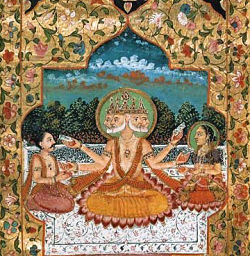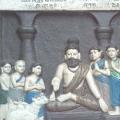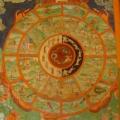5. Do it Yourself: Indra’s Search for the Self in the Upaniṣads
The god Indra seeks to learn the nature of his own self from another god, Prajāpati, and receives an answer worth waiting for.
Themes:
• P. Olivelle (trans.), Upaniṣads (Oxford: 1996).
• B. Black, The Character of the Self in Ancient India: Priests, Kings, and Women in the early Upaniṣads (Albany: 2007).
• B. Black, “The Rhetoric of Secrecy in the Upaniṣads,” in S.E. Lindquist (ed.), Religion and Identity in South Asia and Beyond (Florence: 2011), 101-25.
• J. Ganeri, The Concealed Art of the Soul: Theories of Self and Practices of Truth in Indian Ethics and Epistemology (Oxford: 2007). [Note: the script for this episode is based partially on the discussion of the Upaniṣads in this book.]
• J. Frazier, “Natural Theology in Eastern Religions,” in R. Manning (ed.), The Oxford Handbook of Natural Theology (Oxford: 2013), 166-81.
• D. C. Mathur, “The Concept of Self in the Upanishads: An Alternative Interpretation,” Philosophy and Phenomenological Research 32 (1972), 390-6.
• M. Kapstein, “Indra’s Search for the Self and the Beginnings of Philosophical Perplexity in India,” in M. Kapstein, Reason’s Traces (Somerville: 2001), ch. 2.

Origins


 ..
..



Comments
Enjoying the series so much
Enjoying the series so much that feel like Indra, waiting for the next episode :)
One thing that I am really curious about is to know how these ideas and their validity kept changing with time. I mean when the Upanisads were being written, Prajapati, Indra were still the major gods, right? However, Prajapati's role gets subsumed by Brahma in later texts. Most vedic gods too become minor. And say a later day philosopher comes across this conversation between Prajapti and Indra, will it carry the same weight in his eyes?
In reply to Enjoying the series so much by Mukesh
Changing over time
Hi there - thanks, glad you like the series! I am really enjoying it too, I mean, doing the research and writing on this previously unfamiliar material (with lots of help from Jonardon!). I think you make a good point about how these texts changed as they were read, something we can of course see in the voluminous commentary literature. Indeed the Upanisads themselves illustrate the point, not only in that they considerably change the picture we get from the Vedas but also because different Upanisads were written at different times (even within a single Upanisad you have to reckon with the prospect of layers and compilation of disparate materials). Combined with the problems of dating any of this stuff or assigning genuine authorship, it is a real tangle of history and ideas. Which of course just makes it all the more fascinating. We touch on these issues a bit in the upcoming interview on the Upanisads with Brian Black by the way.
In reply to Changing over time by Peter Adamson
Great! Looking forward to
Great! Looking forward to that talk. Also, hope the other schools like Ajivika, Charvaks which were mentioned in the last episode, get some more mention in upcoming episodes too.
And convey my thanks to Jonardan as well.
Hidden pearls
How interesting that you picked out those specific excerpts about the self, mind and perception! As mindfulness meditation and Buddhism spread, I feel that the subject of no-self gets discussed more and more (I'm thinking popular sources like Sam Harris or Robert Wright, but also "insiders" like Joseph Goldstein), but it always get sold as some great mystical revelation, which, although counter-intuitive, can be experienced by anyone. The Upanishad fragment, on the other hand, put it so simply (and I might be paraphrasing a bit): the perceiver cannot perceive the process/center of perception, for that would require meta-perception (we would get some infinite regress of reverse-homunculi). Like an eye, unable to see itself (mirrors are banned in this universe). So it strikes me as a neat way of commenting on the shortcomings of perception (that anyone can indeed observe via meditation) rather than a proof of non-existence of the perceiving self.
Is this fragment actually older than the Buddha? Was this idea developed, transformed or refuted later on in this context? Perhaps it's addressed in later podcasts, but if not, could you point to other possible texts/authors that deal with this, please?
On another note, I decided to listen to your podcast in a non-canonical order, jumping between Medieval, Islamic and Indian parts, to make it (a bit more) chronological. Although you menetioned what happened when, comparing India with Greece and Rome, I wanted to offer a suggestion: a united timeline for all regions. Perhaps it doesn't make sense to completely mix the episodes, but it could be done on the level of subparts (like stuffing Andalusia after the Early Medieval) - makes one feel like following a global history of philosophy without any gaps ;)
P.S. Thanks also for suggesting Olivelle's translation of the Upanishads - looks just the perfect length to attempt it - especially since it can be borrowed from the openlibrary.org!
In reply to Hidden pearls by Tomasz
The seeing self
That fragment is from the Kena Upanisad, which is certainly early but of uncertain date and, given that the Buddha is also of uncertain date, I wouldn't be confident in saying which is first. Of course the whole Vedanta tradition is a development of the idea expressed here so you could start with those episodes if you haven't heard them yet.
A combined timeline is an interesting idea. Of course you can click back and forth between the different timelines here on the site but I do see it would be nicer to have everyone in one list! Setting it up would be a real pain though, lots of pasting from one web table into another.
In reply to The seeing self by Peter Adamson
Having listened to the rest
Having listened to the rest of the series on India, I now realize I asked too soon - was not expecting so much on the self in what followed! And I realize this is just the tip of the giraffe, but to think how various present day sources for Buddhism freely mix parts of other traditions, and how many gaps they leave... Thanks for filling them!
About the timeline - a comprehensive one would be informative, but perhaps not the most practical. What I meant was just a timeline for subsections, as it would be strange to, e.g., jump in and out of episodes on the same philosopher/tradition. Something like: Presocratics -> Socrates & Plato -> Aristotle -> India Origins -> Hellenistic -> Age of the Sutra -> Late Antiquity -> Islamic Formative -> Early Medieval -> Andalusia -> XIII century -> etc... Or better yet, a block graph of the segments on the same time axis so people could choose on their own (I'm tempted to make one myself).
In reply to Having listened to the rest by Tomasz
Timeline
What would be really brilliant, I think, would be a timeline with figures arranged in side by side columns for China, Greece, India etc so you could read across who is roughly simultaneous with whom. Would be a bit of work but someone could use our timelines here on the website as a basis.
In reply to Timeline by Peter Adamson
Timeline
I imagined it horizontally, like so: https://prnt.sc/mbv4fx but quickly run into the problem of: episode vs historical vs lifespan boundaries (e.g. the Islamic timeline gives mostly dates of death, the XIII and XIV centuries are not actually 100 years, etc.). Turning it into columns would be simple, but how fine-grained should it be to remain readable? At any rate, if you think this could be useful, I might improve it further in my free time (perhaps comments are not the best place for this - sorry for going off on a tangent).
In reply to Timeline by Tomasz
Timeline
Yes, it is not easy especially given the imprecise dates for so many figures. I think it depends what you want to achieve with it: if just seeing which figures were alive at the same time, then multiple columns with lists of names would be best. But actually the first thing I'd do is look around on the internet whether someone hasn't already done something like this; I recently saw a pretty amazing Turkish website that had done it only for the Islamic world.
In reply to Timeline by Peter Adamson
Timeline
Actually, I have been just tossing the names into a spreadsheet to make a visual timeline as i have been going along. It would be pretty trivial for me to transfer this data into the type of spreadsheet you are talking about. I imagine the trickier part would be finding the time to then format it for the web, but i could complete the spreadsheet and send it to you if you'd like.
In reply to Timeline by Alexander Johnson
Timeline
I think I am happy with the timelines as we have them here on the web (for one thing they are suitable for then revising and putting in the book versions, which a spreadsheet probably wouldn't be) but if you had something like this, even if only a work in progress, you could just put it up yourself and send me a link, and I could link to it from the site?
encouragement
keep going bro, your doing great! bet you feel like you've learnt nothing.
Add new comment